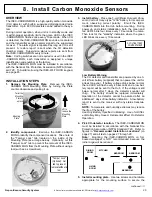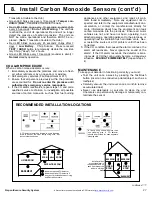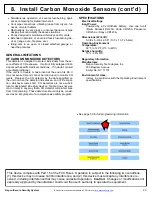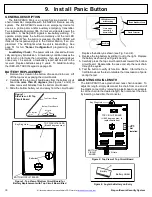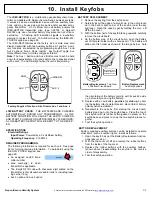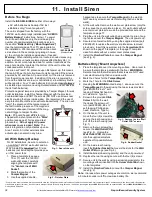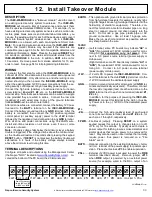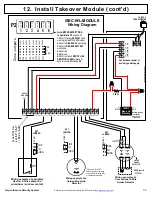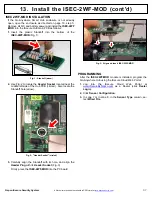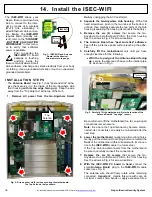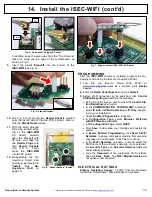
24
All technical manuals are available in PDF format at
tech.napcosecurity.com
Napco iSecure Security System
NOTE:
The mounting plate may be attached to a
plastic
single
-
gang electrical outlet box. Do not attach to metallic
outlet boxes.
*
Refer to NFPA 72 guidelines for spacing reductions when the ceiling height ex-
ceeds 10 feet.
5.
Reinstall the ISEC
-
HEAT into the mounting base.
Insert the ISEC
-
HEAT into the base and turn the top clock-
wise while holding the base stationary until the ISEC
-
HEAT
gently snaps into place.
6.
Map the ISEC
-
HEAT Transmitter
Referring to the
installation instruc-
tions for the Hub
and keypad in use,
enter the following:
•
The
zone
to
which the trans-
mitter will be
mapped.
Note:
This zone
must be pro-
grammed as a
Fire Zone.
•
The 6
-
digit RF
identification number / 1 digit checksum number printed
on the transmitter (include all numbers and/or letters and
leading zeros, if any);
•
The transmitter point number ("1").
7. Install Heat Sensors (cont'd)
E
NSURE
THIS
BOX
IS
1
INCH
X
1
INCH
MOUNTING
TEMPLATE
•
See page 49 for full programming information
7.
Testing the system
Test system with unit mounted. If the system is monitored,
notify the central station of the impending test.
The rate
-
of
-
rise feature may be tested by a quick applica-
tion of heat from any convenient source. A portable hair
dryer is recommended. However, do not apply heat that
exceeds the fixed temperature rating of the detector. If the
fixed temperature is exceeded, the center disk of the detec-
tor will drop and the detector MUST be replaced.
Apply the heat until the local alarm sounds. Verify that the
ISEC
-
HEAT has triggered the correct zone and that the
correct report has been transmitted to central station. Wait
a few minutes and reset the fire circuit. Ensure that the
system returns to a normal status.
WARNINGS
•
HEAT DETECTORS ARE NOT LIFE SAFETY DEVICES:
USE FOR PROPERTY PROTECTION ONLY.
•
WHERE LIFE SAFETY IS REQUIRED, SMOKE DETEC-
TORS MUST ALSO BE USED.
•
BATTERY BACK
-
UP: HEAT DETECTORS SHOULD BE
ELECTRONICALLY SUPERVISED WITH BATTERY
BACKUP AT THE HUB.
•
THE RATE
-
OF
-
RISE MECHANISM MAY BE SUBJECT
TO REDUCED SENSITIVITY OVER TIME. ANNUAL
TESTING OF THE RATE
-
OF
-
RISE OPERATION IS
RECOMMENDED.
•
REFER TO NFPA STANDARD 72 FOR APPLICATION
REQUIREMENTS, TESTING AND MAINTENANCE.
•
DO NOT PAINT THE ISEC
-
HEAT.
•
A TAMPER ZONE TROUBLE WILL RESULT WHEN
THE BATTERIES ARE REPLACED.
















